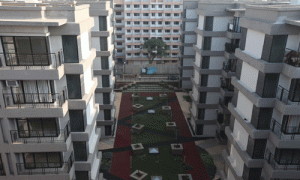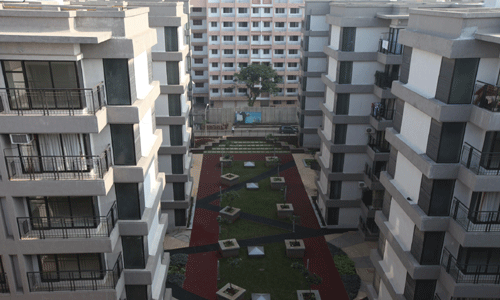 Track2Realty Exclusive: Affordable housing has always been a wishful thought in Mumbai real estate and the call for the same has been reignited post the Government of India calling for a vision document to ensure houses for all by 2022. However, Mumbai is not like the rest of the country and the sky high land prices due to unavailability of developable and licensable land calls for a rethink over what precisely is feasible to create affordable housing stock in the city.
Track2Realty Exclusive: Affordable housing has always been a wishful thought in Mumbai real estate and the call for the same has been reignited post the Government of India calling for a vision document to ensure houses for all by 2022. However, Mumbai is not like the rest of the country and the sky high land prices due to unavailability of developable and licensable land calls for a rethink over what precisely is feasible to create affordable housing stock in the city.
More importantly, it is time to evaluate the practicalities of affordable housing in the city; something that could also offer some viable solutions for the same. Urban management professionals across the Mumbai Metropolitan Region (MMR) are hence busy with their cost and benefit analysis to evaluate what kind of affordable projects should be taken up to meet the growing demand in this segment of real estate. According to them, affordable housing can be created under two circumstances – first by redeveloping the slum which eventually becomes an available stock in the affordable category and can also be sold through extra FAR.
Another segment of affordability is in terms of the budget, ticket size through the incentivised schemes and policies of the government or through subsidised land parcels.
Abhishek Kapoor, Partner, Neumec Group laments the fact that while everyone is building 3 & 4 BHKs and large size apartments, the city of Mumbai is looking at 1 and 2 BHK with a low ticket size and this makes it possible for people to own homes in the aspired vicinity. According to him, presently in Mumbai a large section of the middle class is unable to afford a home in the city and the members living in slums and hutments and they have no better residing options to turn to. In such a scenario, there is an urgent need to devise strategies to encourage the construction of affordable housing for the burgeoning middle class and low income housing for the poor of the city.
“There is a tremendous potential for the affordable housing segment to grow because of the very nature of its business model, which strategically fits into the country’s shifting socio-economic background. The class with affordable income will engorge to over 45 per cent of our population in 20 years. And it is a population that is well informed, assertive and aspirational in their needs and will demand better and more cost-effective housing options,” says Kapoor.
Arvind Jain, Managing Director, Pride Group points out that in a densely populated, land-scarce and, from a real estate perspective, extremely expensive city like Mumbai, the equation for affordable housing necessarily changes. Industry pricing benchmarks go for a toss and have to be recalibrated in accordance with the land costs involved in developing housing in such a city.
“Affordable housing is definitely possible in Mumbai, but the affordability factor is relative to the costs involved in developing any kind of real estate. In other words, affordable housing is possible and happening in Mumbai, but it costs a lot more than it would in most other cities, and – because of the land costs involved – is largely being developed in the furthest suburbs of MMR and the newly emergent locations of Navi Mumbai, or in the few pockets of land made available by the government specifically for budget housing development,” says Jain.
Kishor Pate, CMD of Amit Enterprises Housing points out that slum rehabilitation (SRA) is one of the most logical answers to Mumbai’s affordable housing conundrum, but it will take great political will and a lot more incentivization for developers to make slum redevelopment feasible and attractive. The problem is that slum land in Mumbai tends to be quite central, making it far more attractive for developers to build costlier housing on such land.
“The government needs to make slum land earmarked for development available specifically for low-income housing, or at least stipulate a larger percentage of the overall development for such housing. Also, slum redevelopment tends to be very complicated because such land is invariably controlled by lower-rung politicians and local strongmen who have vested interests in keeping the things exactly how they are, and also because it is very difficult to get a sufficient saturation of slum dwellers to buy into the concept of slum redevelopment,” says Pate.
Talking about the feasibility of affordable housing in Mumbai, Rohit Poddar, Managing Director, Poddar Developers says it is the need of the hour without doubt. But to succeed in this segment of housing the developer needs to have a manufacturer’s mindset and build capacity across each of the value pots – land aggregation, PM and CM, retail finance and a strong trustworthy brand. Additionally the government must also do their part and provide speedy approvals and infrastructure like MUTP, water, electricity and roads.
“I don’t believe that affordable housing in Mumbai is feasible only with the slum land. There are adequate land parcels available in the periphery of the suburbs where the local train service is used for connectivity. As far as defunct mill land is concerned, such land can be used by creating a cross subsidy scheme like in Jaipur for instance. Additional FSI is given for luxury and commercial buildings and a certain percentage of the overall FSI (say 20%) has to be used to create affordable housing at affordable prices which are set by the government,” says Poddar.
This raises a question as to how far defunct mill land can be used for affordable housing in the city? Analysts point out that technically and hypothetically, Mumbai’s defunct mill land is an ideal source of land for affordable housing. But in reality, developers who bid for such land are looking only to build super-expensive housing there. This is understandable because of the sky-high cost of such land. However, the government can and should consider demarcating at least a sizeable portion of the defunct mill land solely for affordable housing.
In a nutshell, in the evaluation of practicalities and feasibility what comes out strongly is that the affordable housing has a strong linkage with the land competence as well as the facilitating policies. In a city like Mumbai affordable housing will always be a wishful thought unless a comprehensive policy is rolled out for the same. The policies must be in sync with the market realities; something that could encourage and facilitate the developers in creating the housing stock for the masses at large.





